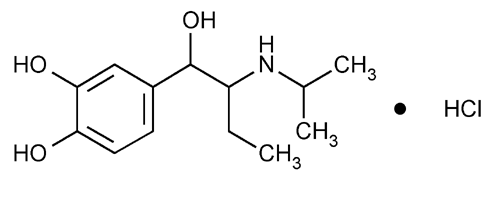Isoetharine Hydrochloride
1,2-Benzenediol, 4-[1-hydroxy-2-[(1-methylethyl)amino]butyl]-, hydrochloride.
3,4-Dihydroxy-
» Isoetharine Hydrochloride contains not less than 97.0 percent and not more than 102.0 percent of C13H21NO3·HCl, calculated on the dried basis.
Packaging and storage—
Preserve in tight containers.
Identification—
B:
A solution (1 in 100) responds to the tests for Chloride  191
191 .
.
pH  791
791 :
between 4.0 and 5.6, in a solution (1 in 100).
:
between 4.0 and 5.6, in a solution (1 in 100).
Loss on drying  731
731 —
Dry it at 100
—
Dry it at 100 for 4 hours: it loses not more than 1.0% of its weight.
for 4 hours: it loses not more than 1.0% of its weight.
Aromatic ketones—
Its absorptivity (see Spectrophotometry and Light-scattering  851
851 ) at 312 nm, determined in a solution in 0.01 N hydrochloric acid containing 2.0 mg per mL, is not more than 0.20.
) at 312 nm, determined in a solution in 0.01 N hydrochloric acid containing 2.0 mg per mL, is not more than 0.20.
Assay—
Standard preparation—
Dissolve an accurately weighed quantity of USP Isoetharine Hydrochloride RS in freshly prepared sodium bisulfite solution (3 in 1000) to obtain a solution having a concentration of about 5 mg per mL. Transfer 5.0 mL of this solution to a 50-mL volumetric flask, dilute with 0.17 N acetic acid to volume, and mix to obtain a solution having a known concentration of about 500 µg per mL.
Assay preparation—
Transfer about 125 mg of Isoetharine Hydrochloride, accurately weighed, to a 25-mL volumetric flask, dissolve in sodium bisulfite solution (3 in 1000), dilute with sodium bisulfite solution to volume, and mix. Transfer 5.0 mL of this solution to a 50-mL volumetric flask, dilute with 0.17 N acetic acid to volume, and mix.
Chromatographic system
(see Chromatography  621
621 )—The liquid chromatograph is equipped with a 278-nm detector and a 4-mm × 30-cm column that contains packing L1. The mobile phase is 0.17 N acetic acid, having a flow rate of about 2.2 mL per minute. Chromatograph five replicate injections of the Standard preparation, and record the peak responses as directed for Procedure: the relative standard deviation is not more than 3.0%.
)—The liquid chromatograph is equipped with a 278-nm detector and a 4-mm × 30-cm column that contains packing L1. The mobile phase is 0.17 N acetic acid, having a flow rate of about 2.2 mL per minute. Chromatograph five replicate injections of the Standard preparation, and record the peak responses as directed for Procedure: the relative standard deviation is not more than 3.0%.
Procedure—
Using a microsyringe or sampling valve, chromatograph 10 µL of the Standard preparation, and adjust the specimen size and other operating parameters, if necessary, until satisfactory chromatography and peak responses are obtained. Chromatograph equal volumes of the Standard preparation and the Assay preparation, record the chromatograms, and measure the peak responses. Calculate the quantity, in mg, of C13H21NO3·HCl in the portion of Isoetharine Hydrochloride taken by the formula:
0.25C(hU / hS)
in which C is the concentration, in µg per mL, of USP Isoetharine Hydrochloride RS in the Standard preparation; and hU and hS are the peak responses obtained from the Assay preparation and the Standard preparation, respectively.
Auxiliary Information—
Please check for your question in the FAQs before contacting USP.
| Topic/Question | Contact | Expert Committee |
| Monograph | Daniel K. Bempong, Ph.D.
Senior Scientist 1-301-816-8143 |
(MDPS05) Monograph Development-Pulmonary and Steroids |
| Reference Standards | Lili Wang, Technical Services Scientist 1-301-816-8129 RSTech@usp.org |
USP32–NF27 Page 2692
